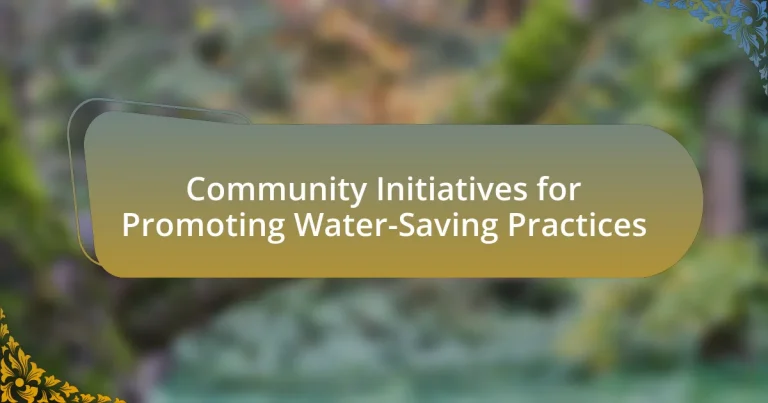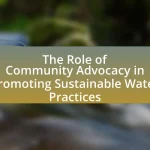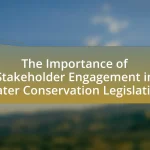Community initiatives for promoting water-saving practices are programs designed to educate and engage residents in reducing water consumption through workshops, challenges, and partnerships. These initiatives aim to enhance awareness of water conservation, leading to behavioral changes that significantly lower water usage and foster community collaboration. Key goals include reducing water consumption, promoting sustainable management, and providing economic benefits through lower water bills. Local governments play a vital role by implementing supportive policies and incentives, while challenges such as funding and community engagement can hinder effectiveness. Overall, these initiatives are essential for addressing water scarcity and encouraging sustainable practices within communities.

What are Community Initiatives for Promoting Water-Saving Practices?
Community initiatives for promoting water-saving practices include programs and campaigns designed to educate and engage residents in reducing water consumption. These initiatives often involve workshops, community challenges, and partnerships with local organizations to raise awareness about the importance of water conservation. For example, the “Save Water, Save Life” campaign in California has successfully reduced residential water use by 20% through community engagement and education efforts. Such initiatives are crucial in addressing water scarcity issues and fostering sustainable practices within communities.
How do these initiatives impact local communities?
Community initiatives for promoting water-saving practices positively impact local communities by enhancing water conservation awareness and reducing water usage. These initiatives often involve educational programs that inform residents about the importance of water conservation, leading to behavioral changes that result in lower water consumption. For example, a study by the American Water Works Association found that communities implementing water-saving campaigns reduced their water usage by an average of 15%. Additionally, these initiatives can foster community engagement and collaboration, as residents work together to implement sustainable practices, ultimately strengthening community ties and improving local environmental conditions.
What are the key goals of water-saving initiatives?
The key goals of water-saving initiatives are to reduce water consumption, promote sustainable water management, and raise awareness about water conservation. These initiatives aim to decrease the demand for freshwater resources, which is critical as global water scarcity affects over 2 billion people. By implementing practices such as rainwater harvesting, efficient irrigation techniques, and public education campaigns, these initiatives help communities conserve water and protect local ecosystems. Furthermore, studies show that effective water-saving measures can lead to a reduction in water bills for households, thereby providing both environmental and economic benefits.
How do community members participate in these initiatives?
Community members participate in initiatives promoting water-saving practices through active engagement in educational programs, workshops, and local events. These activities often involve hands-on demonstrations of water-efficient techniques, such as rainwater harvesting and xeriscaping, which empower individuals to implement these practices in their own homes. Research indicates that community involvement in such initiatives can lead to a significant reduction in water usage; for example, a study by the American Water Works Association found that communities that engaged residents in water conservation efforts reduced their water consumption by up to 20%.
Why are water-saving practices important for communities?
Water-saving practices are important for communities because they ensure sustainable water management, which is crucial for environmental health and economic stability. By implementing these practices, communities can reduce water waste, conserve resources, and mitigate the impacts of droughts and climate change. For instance, the U.S. Environmental Protection Agency reports that water-efficient fixtures and appliances can save households up to 20% on water bills, translating to significant savings for the community as a whole. Additionally, conserving water helps protect local ecosystems, as reduced water extraction from rivers and lakes maintains biodiversity and supports wildlife habitats.
What environmental benefits do water-saving practices provide?
Water-saving practices provide significant environmental benefits, including the conservation of natural resources and the reduction of pollution. By using less water, these practices help preserve freshwater ecosystems, which are vital for biodiversity. For instance, the U.S. Environmental Protection Agency states that reducing water usage can lead to lower energy consumption, as less energy is required for water treatment and distribution. Additionally, water-saving measures can decrease runoff and erosion, which in turn minimizes the transport of pollutants into waterways, thereby improving water quality.
How do water-saving practices contribute to economic savings?
Water-saving practices contribute to economic savings by reducing water bills and lowering the costs associated with water treatment and distribution. For instance, households that implement water-efficient fixtures can save up to 30% on their water usage, translating to significant financial savings over time. Additionally, municipalities that promote water conservation can decrease infrastructure costs, as less water needs to be treated and delivered, which can lead to lower taxes or utility rates for residents. Studies have shown that communities that adopt water-saving measures can save millions annually, highlighting the direct correlation between conservation efforts and economic benefits.

What types of community initiatives exist for promoting water-saving practices?
Community initiatives for promoting water-saving practices include educational programs, community gardens, rainwater harvesting systems, and incentive-based programs. Educational programs raise awareness about water conservation techniques, while community gardens demonstrate sustainable practices and efficient water use. Rainwater harvesting systems encourage residents to collect and utilize rainwater, reducing reliance on municipal water supplies. Incentive-based programs, such as rebates for water-efficient appliances, motivate individuals to adopt water-saving technologies. These initiatives collectively contribute to a culture of conservation and sustainable water management within communities.
How do educational programs influence water-saving behaviors?
Educational programs significantly influence water-saving behaviors by increasing awareness and knowledge about water conservation practices. Research indicates that individuals who participate in educational initiatives demonstrate a higher likelihood of adopting water-saving measures, such as reducing water usage in households and implementing efficient irrigation techniques. For instance, a study published in the Journal of Environmental Education found that participants in a water conservation education program reduced their water consumption by an average of 20% over six months. This evidence underscores the effectiveness of educational programs in fostering sustainable water-saving habits within communities.
What topics are typically covered in water conservation education?
Water conservation education typically covers topics such as the importance of water resources, methods for reducing water usage, the impact of water scarcity, and techniques for sustainable water management. These topics are essential for raising awareness about the need for conservation and equipping individuals and communities with practical strategies to save water. For instance, educational programs often include information on efficient irrigation practices, rainwater harvesting, and the benefits of xeriscaping, which can significantly reduce water consumption in landscaping.
How effective are these educational programs in changing habits?
Educational programs focused on water-saving practices are highly effective in changing habits. Research indicates that participants in these programs often demonstrate significant reductions in water usage, with studies showing up to a 30% decrease in consumption after implementation. For instance, a study conducted by the American Water Works Association found that community education initiatives led to a measurable shift in behavior, with 70% of participants reporting increased awareness and adoption of water-saving techniques. This evidence underscores the effectiveness of educational programs in fostering sustainable habits related to water conservation.
What role do local governments play in these initiatives?
Local governments play a crucial role in community initiatives for promoting water-saving practices by implementing policies, providing resources, and facilitating community engagement. They develop and enforce regulations that encourage water conservation, such as restrictions on water usage during droughts and incentives for using water-efficient appliances. For example, many local governments offer rebates for residents who install rain barrels or drought-resistant landscaping, directly promoting water-saving behaviors. Additionally, local governments often collaborate with community organizations to raise awareness and educate the public about the importance of water conservation, thereby fostering a culture of sustainability within the community.
What policies support community water-saving initiatives?
Policies that support community water-saving initiatives include water conservation regulations, financial incentives for water-efficient technologies, and public education campaigns. Water conservation regulations, such as restrictions on outdoor watering during droughts, directly encourage communities to reduce water usage. Financial incentives, like rebates for installing low-flow fixtures or drought-resistant landscaping, motivate residents to adopt water-saving practices. Public education campaigns raise awareness about the importance of water conservation and provide practical tips for reducing water consumption. These policies collectively foster a culture of water efficiency within communities, leading to sustainable water management.
How can local governments incentivize water conservation?
Local governments can incentivize water conservation by implementing tiered water pricing structures that charge higher rates for excessive usage. This approach encourages residents to reduce their water consumption to avoid higher bills. For example, cities like San Diego have successfully adopted this model, resulting in a 20% reduction in water use during drought conditions. Additionally, local governments can offer rebates for water-efficient appliances and landscaping, which have been shown to lead to significant water savings. In 2020, the California State Water Resources Control Board reported that rebate programs led to a reduction of over 100,000 acre-feet of water usage annually. These strategies effectively promote sustainable water practices within communities.

What challenges do community initiatives face in promoting water-saving practices?
Community initiatives face several challenges in promoting water-saving practices, including lack of funding, insufficient community engagement, and varying levels of awareness about water conservation. Limited financial resources hinder the ability to implement effective programs and outreach efforts. Additionally, without strong community involvement, initiatives may struggle to gain traction and achieve sustainable behavior change. Research indicates that awareness levels can significantly differ among community members, leading to inconsistent participation in water-saving practices. For instance, a study by the American Water Works Association found that communities with targeted educational campaigns saw a 20% increase in water-saving behaviors compared to those without such initiatives.
How can communities overcome resistance to water-saving practices?
Communities can overcome resistance to water-saving practices by implementing educational programs that highlight the benefits of conservation. These programs can demonstrate how water-saving measures reduce costs and enhance sustainability, thereby addressing misconceptions and fostering acceptance. For instance, studies show that communities that engaged in outreach efforts, such as workshops and informational campaigns, experienced a 20% increase in participation in water-saving initiatives. Additionally, involving local leaders and influencers can help build trust and encourage community members to adopt these practices.
What common misconceptions hinder water conservation efforts?
Common misconceptions that hinder water conservation efforts include the belief that water-saving measures are too costly and that individual actions have little impact. Many people think that implementing water-efficient appliances or landscaping requires significant financial investment, which discourages them from making changes. However, studies show that water-efficient technologies can lead to long-term savings on water bills, often paying for themselves within a few years. Additionally, the perception that individual contributions are insignificant overlooks the cumulative effect of collective action; for instance, if every household in a community reduces water usage by just 10%, it can lead to substantial overall savings and conservation.
How can community leaders address these misconceptions?
Community leaders can address misconceptions about water-saving practices by implementing educational campaigns that provide accurate information and practical demonstrations. These campaigns can include workshops, informational brochures, and community meetings that clarify the benefits and methods of water conservation. Research shows that communities with active educational initiatives see a 20% increase in water-saving behaviors among residents, as evidenced by a study conducted by the American Water Works Association. By fostering open dialogue and providing resources, community leaders can effectively dispel myths and encourage sustainable practices.
What resources are available to support community water-saving initiatives?
Community water-saving initiatives can be supported by various resources, including grants, educational programs, and partnerships with local organizations. For instance, the U.S. Environmental Protection Agency (EPA) offers funding through its WaterSense program, which provides financial assistance for water efficiency projects. Additionally, local governments often have programs that educate residents on water conservation techniques, such as rainwater harvesting and xeriscaping. Nonprofit organizations, like the Nature Conservancy, also provide resources and tools to help communities implement sustainable water practices. These resources collectively enhance community efforts to conserve water and promote sustainable usage.
What organizations provide funding for water conservation projects?
Organizations that provide funding for water conservation projects include the Environmental Protection Agency (EPA), the National Oceanic and Atmospheric Administration (NOAA), and the World Wildlife Fund (WWF). The EPA offers various grant programs aimed at improving water quality and conservation efforts, while NOAA supports initiatives that promote sustainable water management. The WWF funds projects that focus on freshwater conservation and sustainable water use practices. These organizations are recognized for their commitment to enhancing water conservation through financial support and resources.
How can communities access educational materials on water-saving practices?
Communities can access educational materials on water-saving practices through local government programs, non-profit organizations, and online resources. Local governments often provide workshops and distribute pamphlets that detail effective water-saving techniques. Non-profit organizations, such as the Environmental Protection Agency, offer free online resources, including guides and toolkits, that educate the public on sustainable water use. Additionally, websites like WaterSense provide comprehensive information and resources tailored to various community needs, ensuring that residents can easily find and implement water-saving practices.
What are some best practices for implementing successful water-saving initiatives?
Successful water-saving initiatives can be implemented by adopting best practices such as conducting thorough assessments of water usage, engaging the community through education and outreach, and utilizing technology for monitoring and management. Assessing water usage helps identify areas where savings can be achieved; for instance, the U.S. Environmental Protection Agency (EPA) reports that households can save up to 20% on water bills by fixing leaks and using water-efficient fixtures. Community engagement fosters a culture of conservation, as demonstrated by programs like the California Water Efficiency Partnership, which emphasizes public education on water-saving techniques. Additionally, employing smart irrigation systems and water management technologies can optimize water use, with studies showing that smart controllers can reduce outdoor water use by 30-50%. These practices collectively enhance the effectiveness of water-saving initiatives.
How can communities effectively measure the impact of their initiatives?
Communities can effectively measure the impact of their initiatives by utilizing specific metrics such as water usage reduction, participant engagement levels, and behavioral changes in water conservation practices. For instance, tracking the volume of water saved through initiatives like rainwater harvesting or xeriscaping can provide quantifiable data on effectiveness. Additionally, surveys and feedback mechanisms can assess community awareness and participation rates, which are crucial for understanding the initiative’s reach and influence. Studies have shown that communities implementing structured evaluation frameworks, such as the Logic Model, can systematically assess outcomes and adjust strategies accordingly, leading to improved water-saving practices.
What strategies can enhance community engagement in water conservation?
Strategies that can enhance community engagement in water conservation include educational programs, community workshops, and incentive-based initiatives. Educational programs raise awareness about the importance of water conservation and provide practical tips for reducing water usage, which can lead to behavioral changes among community members. Community workshops facilitate hands-on learning experiences, allowing participants to engage directly with water-saving techniques, such as rainwater harvesting or xeriscaping. Incentive-based initiatives, such as rebates for water-efficient appliances or discounts for reduced water usage, motivate residents to adopt conservation practices. Research indicates that communities implementing these strategies see a measurable decrease in water consumption, demonstrating their effectiveness in fostering engagement and promoting sustainable practices.


